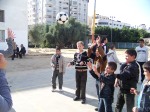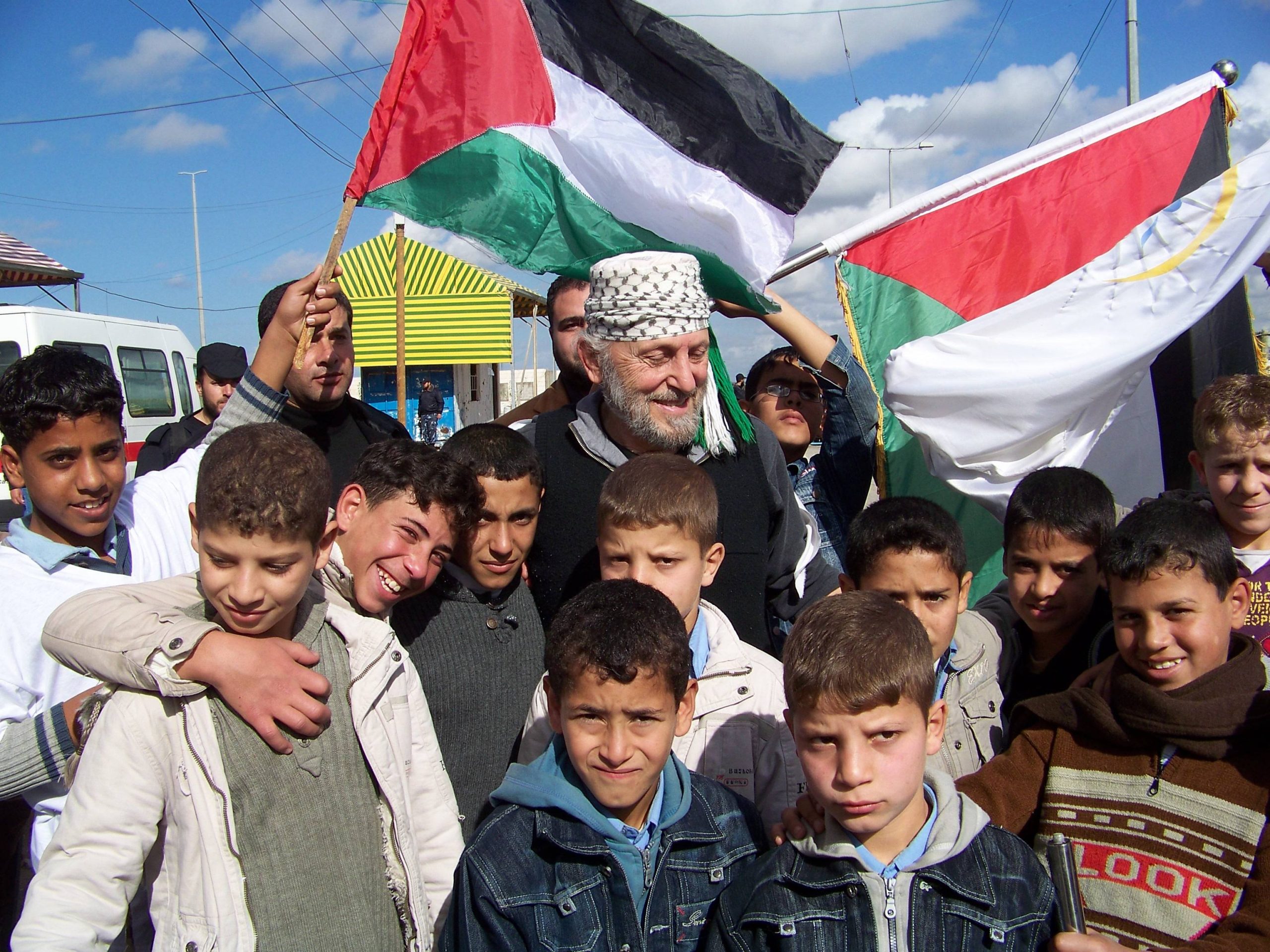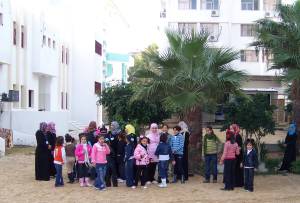Gaza Overview
For an overview of how Gaza became an outdoor prison, I recommend you click on “Overview on Gaza” on the right column under “Pages”. How to read Cairo/ Gaza report:This report of my trips to Cairo and Gaza, is in two parts. Please read part 1 (Cairo) first, which is seen below part 2 (Gaza), then return to this section for part 2. Note that there is more of each report, including pictures, if you click on “Read more” at the end of each part. Excerpts from Gaza part 2:On Friday, January 1st, we visited an orphanage, where about 20 of us, including the four Rabbis, had lunch. We visited with the 50 boys and 40 girls as the children sat at tables with us. I and some of the teachers were able to translate. We played out in the playground with the children and left the toys that we brought for them.

Boys playing with a soccer ball at the Al-amal Institute for Orphans, in Gaza City, January 1
, 2010.
For more information see: Al-amal Institute for Orphans:
http://www.vivapalestina.org/resources/Al_Amal-profile.pdf
We also got about a half hour tour of the school with information about the facility. We were also shown some disturbing footage of the Israeli attack, from the year before, and how many children were killed or became orphans as a result. A special highlight, on Friday afternoon, was a soccer game in Gaza City. The internationals were challenged to a soccer game by the local team, as they were all decked out in their yellow uniforms and spent hours practicing for the game. Of course, I played with the internationals and instructed my team not tobeat them, as that would be humiliating to the local community. So we laid back and let them beat us 4 to 2 thus allowing them the glory of winning something—even if it was only a soccer game against a bunch of novices. (This is my bit of humor in an otherwise dismal situation.)
Some young girls with their female teacher at the orphanage.
Another major development in the soccer game was when they would not allow the women in our group to play. There was a major struggle on the field as we debated the issues about allowing the international women to participate. The Gaza team threatened to walk off the field and we did not want to make an international incident about it, thus embarrassing the local community. (Besides we were on their turf and we needed to respect their traditions even though it was contrary to our belief systems.) We finally reached a compromise in which it was agreed that, at the end of the formal game, the internationals could split into two teams, including the women and play each other. We ran out of time and that game never took place as we had to prepare for the evening events.
Friday night, January 1st, we had our farewell dinner in the hotel. After dinner we were treated to a PowerPoint presentation by the Palestine Human Rights organization where we got specific data about the carnage that resulted from the Israeli invasion. For accurate, reliable and shocking statistics of the carnage of that attack, I recommend you visit The Palestinian Centre for Human Rights: http://www.pchrgaza.org/portal/en/
Saturday morning, January 2nd, we gathered in the lobby at 9 am to board buses for the return trip. A major conflict developed as about 20 internationals wanted to stay behind to freely visit with families as we were originally told we could do. There were heated debates with Hamas security. Around 11:30 am, the two buses pulled out with some of the internationals having slipped away the night before. I was told, on the way back, that they were all rounded up and put on another bus out of Gaza.
Before leaving Gaza City, the two buses passed by the Gaza Freedom March mural this was the gift of the international community to the people of Gaza. The mural was the brain child of Kathleen Crocetti who spent some 600 hours, involving dozens of women back in Santa Cruz, California, in preparing this work of art. All this was coordinated (via e-mails) with women in Gaza to determine size and content. This master piece was then labeled, dismantled into 25 sections and carried to the site in Gaza. It was reassembled, one section at a time, as a permanent memorial to the suffering of the people. The crew that installed this work of art in Gaza, spent countless hours on the project. At one point, as they were running out of time, local community citizens, along with some of the Hammas security people, pitched in to ensure the 11th hour completion before we left Gaza. For Kathleen’s report see: http://communityartactivism.blogspot.com/

Back to Cairo
The ride back was miserable as it was in an old bus with no restroom and we arrived in Cairo around midnight. Again, the Egyptian Security escorted the caravan all the way back to Cairo. Back in Cairo, Sunday, January 3rd, I was glad to be re-united with my Michigan Peace Team mates and they were all happy to see me, as they plied me with questions and were eager to know about my experiences. Some views as reported by those who were in Gaza with me. On Sunday my team mates and I attended a Code Pink de-briefing with many who were in Gaza with me. As we each took turns briefly outlining the highlights in Gaza, my team members took notes and outlined a report they sent to the Michigan Peace Team in Gaza blog: http://mptinGaza.blogspot.com(see below a few brief excerpts.)
The Rafah Border Crossing:
At the Rafah border crossing from Egypt to Gaza, Egyptian authorities appear to partner with Hammas in the management of the border crossing. GFM delegates said they received horrible treatment from Egyptian authorities at the border.
The blockade, on-going occupation of Gaza, and the role of Israel, Egypt, USA:
The GFM eyewitnesses who crossed the Egyptian border and traveled through Gaza confirm that Gaza is sealed by land, airspace, and sea. A small part of the delegation experienced artillery fire from the border into Gaza. Moreover, experiences of the GFM delegation leads them to conclude that Israel, Egypt, and the United States collaborate to maintain the blockade and siege.
Tour of Horror:
The GFM delegation viewed the horror of the devastation in Gaza resulting from the Israeli invasion and attack on Gaza during Operation Cast Lead, December 2008 to January 2009 and the assaults that have continued since that time. The delegation visited hospitals, agencies, schools, and humanitarian centers. Also they met with families still suffering from devastation and loss. Military action by Israel has had a terrible impact on the economy. People live in misery. Unemployment is skyrocketing. Because Israel refused to admit construction materials, a year after the bombing, Gaza still lays in waste. One GFM delegate said, “There is no way to live through the siege.”
Resilience:
The GFM delegation learned about the incredible resilience of Gazans. Though the grip of the occupation and now the added blockade brings misery to the people of Gaza, their spirit is not crushed. Gazans rally together and care for one another. They are convinced that the blockade and the occupation will end, and until that time, they believe their spirit will prevail. Delegates also noted that hope filled signs of art, music, dance, and humor are evident and growing within the Gazan society.
Views on Hamas:
Most of the GFM delegation was surrounded by Hamas security throughout their time in Gaza. Some ingenious GFM members were able to slip away from Hamas security and freely visited Gazans from north to south. All were shocked to see that Hamas did not allow women to participate in the Gaza Freedom March. Most of the GFM delegates are shocked by the Hamas repression; some conclude Gaza has become a police state under Hamas rule; one member of the delegation understands Hamas actions, saying “Hamas has to do what they have to do in order to maintain order in the midst of chaos.”
Significance of the Tunnels:
A GFM delegate said, “Every sip of soda, every bit of food, every piece of toilet paper used by the delegation had arrived to Gaza via the tunnels.” She noted with irony that imports to Gaza via the tunnels are labeled “illegal” by Israel, Egypt, and the United States governments.
Presence of the Rabbis:
Four Jewish Rabbis who have committed their lives trying to apply justice in Gaza, and Palestine joined the Gaza Freedom March delegation to Gaza. GFM delegates describe the presence of these Rabbis as a pure gift. Their presence, words, and actions brought hope to Gaza; their love and solidarity were treasured by Gazans.
Support the Jewish Community that Stands for Freedom:
Yusif urged the Gaza Freedom March to support the courageous Jewish people who stand for justice and work to end the occupation both in Israel and around the world, at the risk of being ostracized from their community.
Gazan Message: Take Responsibility and Do Something!
Gazans consistently related this message to the GFM delegation:
[pullquote_left]We very much like having you in Gaza, but at the same time we do ask this: Don’t only come and stand with us for a few hours.
Please go home and do something about this unjust situation![/pullquote_left]
Message of Hope:
When returning home, everyone was encouraged to work tirelessly to end the siege on Gaza. We hope you will be able to join us in finding ways “to do something about this unjust situation.”
Goodbye to Cairo
Sunday evening, January 3rd, we had our last dinner together as we were joined by Ahmad before we left Cairo. Apparently, during the four days I was in Gaza, my MPT mates:
1) Attempted to get on a public bus, with intension of going to the Rafah border, hoping to gain entry into Gaza. Of course, the all-seeing eye of the Egyptian police, escorted them off the bus and back to their hotel.
2) Made use of some of their time (that was not spent in hunger strikes and in demonstrations) by being able to do some sightseeing. They communicated with my friend, Ahmad, who advised them on how to best get to the pyramids, museums, etc. So despite all the frustrations of not going to Gaza, and suffering with the Cairo police at demonstrations, they were able to get some value in seeing the wonders of the ancient civilization.
Monday afternoon, January 4th, I said goodbye to Cairo again and flew to Amman, Jordon to spend some quality time with some of my other cousins and their families. While in Amman, I used my cousin’s lap top to finally communicate with family members and check my overflowing e-mails.
Next report
-
Next report
The above report covers my time in Cairo and Gaza. I spent 27 days total in the Middle East and have yet much to report on my time in Amman, Jordon, Tel Aviv, Israel and Ramallah, West Bank. Since there is a lot to report from those visits I will post another report, with pictures, soon. I will outline problems, solutions and recommendations along with some conclusions and remarks.
Acknowledgements
I want to also take the opportunity to thank my friend and administrative assistant, Kim Bergier, as without her, none of you would have gotten anything (including this report). She has been my support person back in Michigan, receiving and forwarding my reports, plus maintained my schedule and contact information. She has received my phone calls and followed my requests at all hours of the day and night and has called me to relay information and check on my well being.



The subject is fully clear but why does the text lack clarity? But in general your blog is great.
Thank you for your feedback.
The text is in the process of being more consistent and larger, when possible.